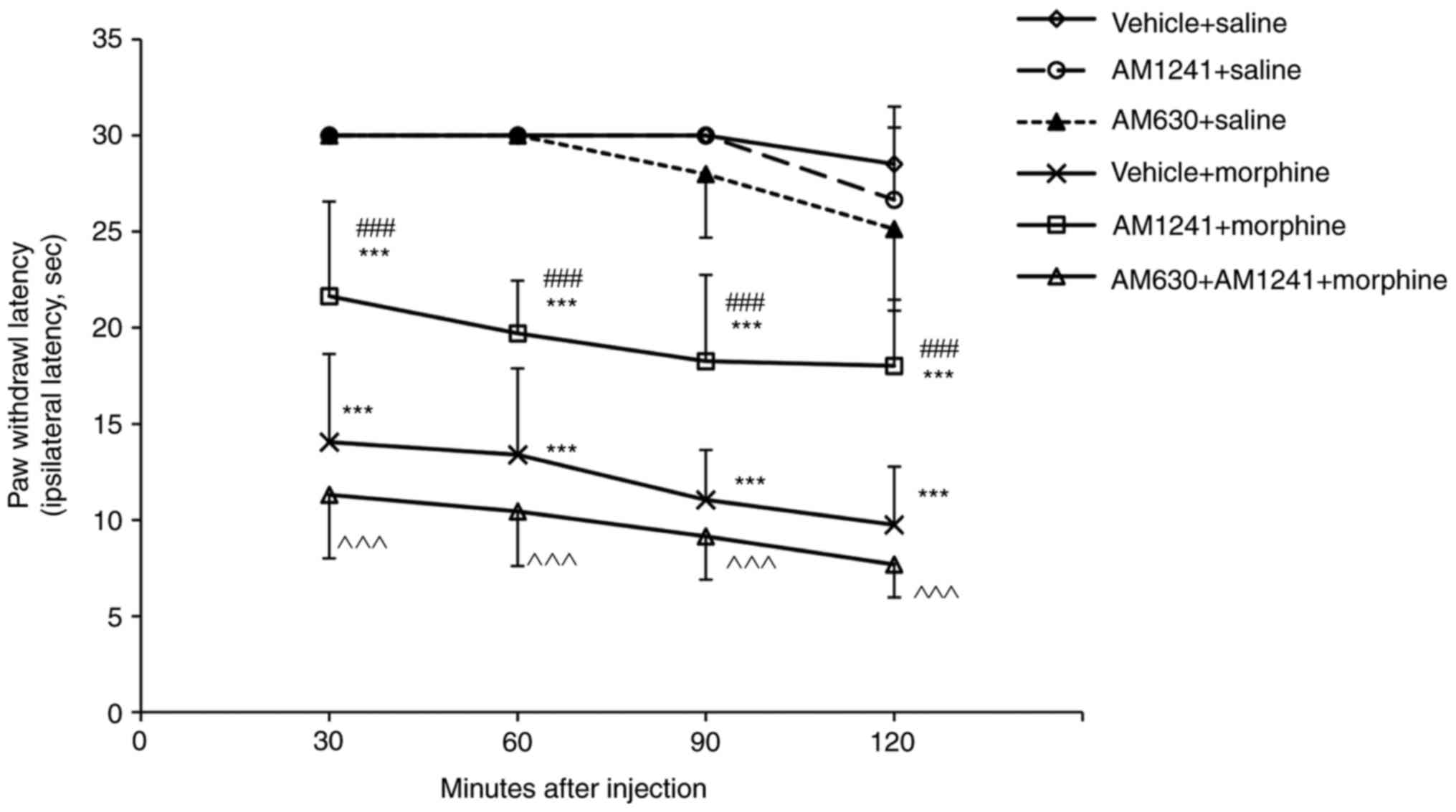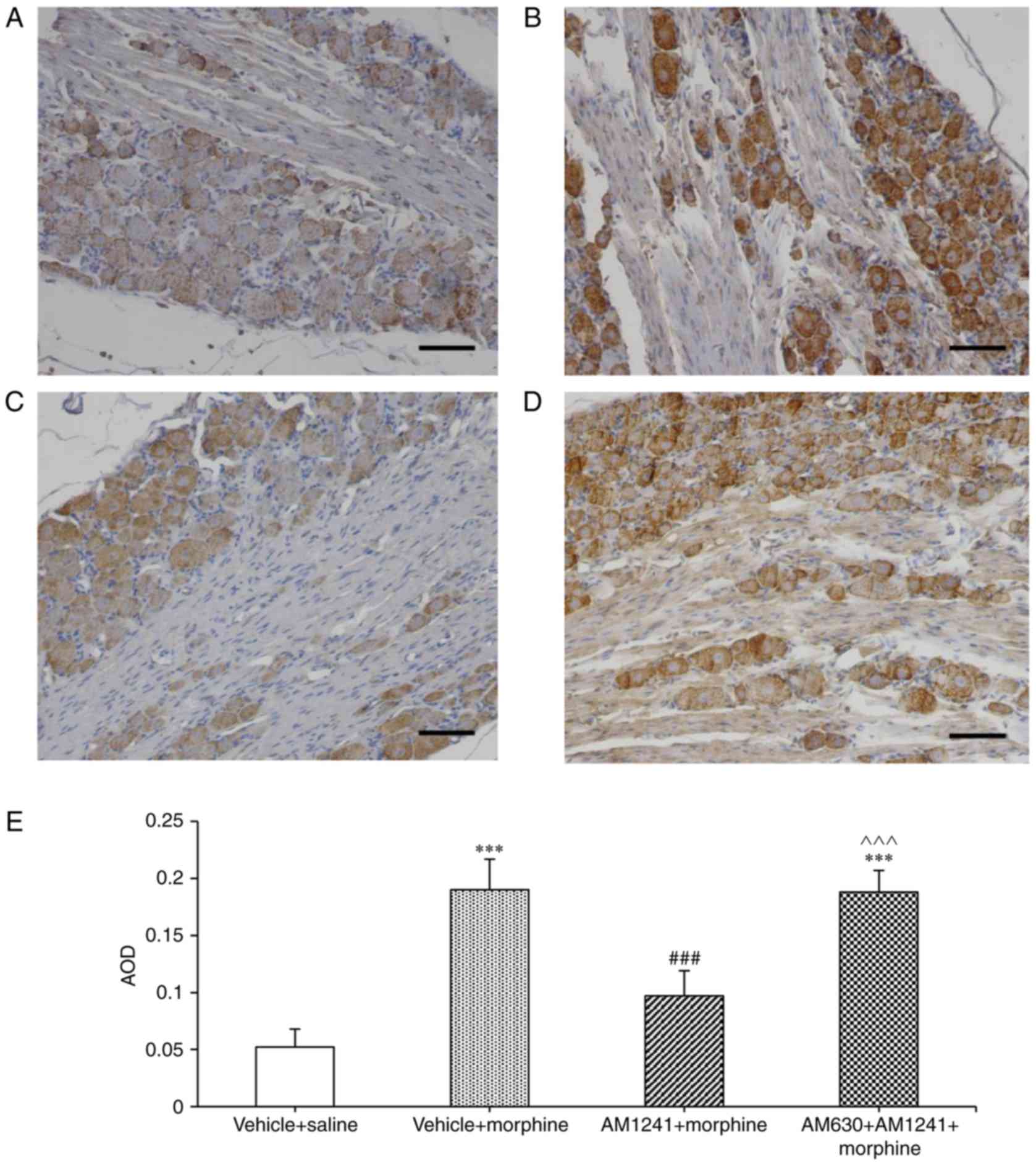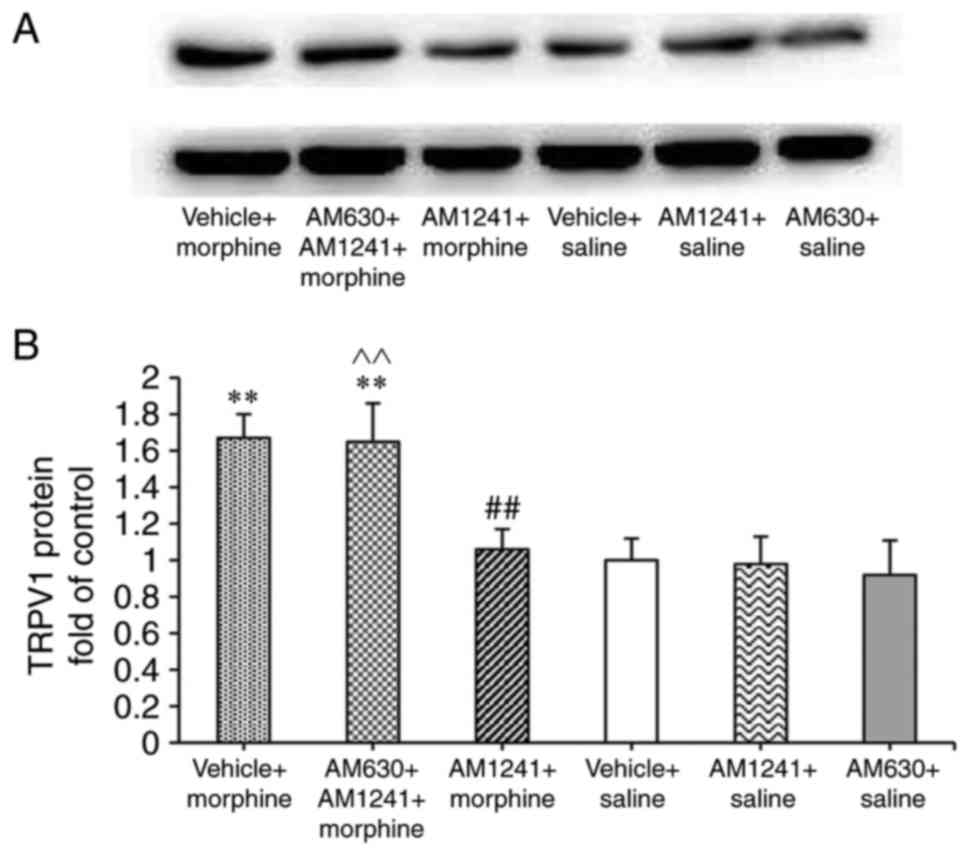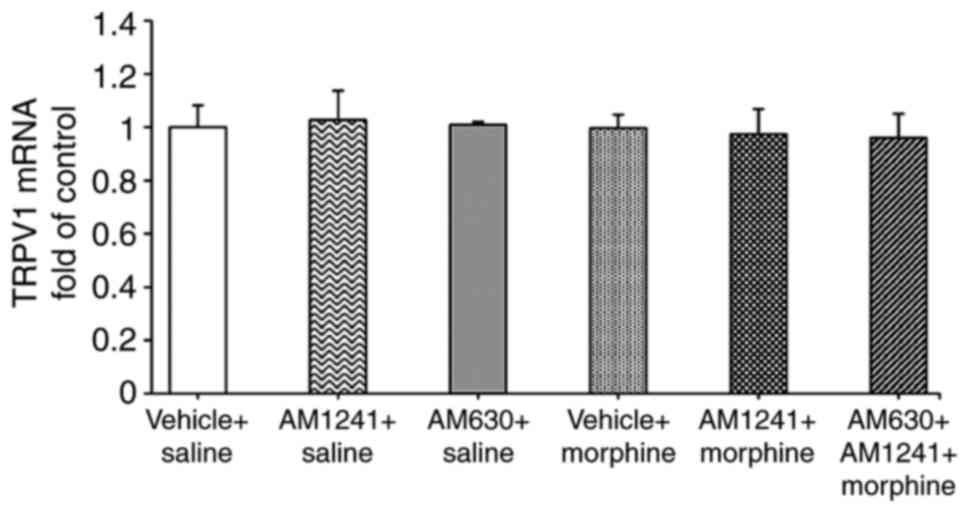|
1
|
Mercadante S: The use of opioids for
treatment of cancer pain. Expert Opin Pharmacother. 16:389–394.
2015.PubMed/NCBI
|
|
2
|
Watkins LR, Hutchinson MR, Johnston IN and
Maier SF: Glia: Novel counter-regulators of opioid analgesia.
Trends Neurosci. 28:661–669. 2005. View Article : Google Scholar : PubMed/NCBI
|
|
3
|
Nagi K and Piñeyro G: Regulation of opioid
receptor signalling: Implications for the development of analgesic
tolerance. Mol Brain. 4:252011. View Article : Google Scholar : PubMed/NCBI
|
|
4
|
Tumati S, Largent-Milnes TM, Keresztes A,
Ren J, Roeske WR, Vanderah TW and Varga EV: Repeated morphine
treatment-mediated hyperalgesia, allodynia and spinal glial
activation are blocked by co-administration of a selective
cannabinoid receptor type-2 agonist. J Neuroimmunol. 244:23–31.
2012. View Article : Google Scholar : PubMed/NCBI
|
|
5
|
Ledent C, Valverde O, Cossu G, Petitet F,
Aubert JF, Beslot F, Böhme GA, Imperato A, Pedrazzini T, Roques BP,
et al: Unresponsiveness to cannabinoids and reduced addictive
effects of opiates in CB1 receptor knockout mice. Science.
283:401–404. 1999. View Article : Google Scholar : PubMed/NCBI
|
|
6
|
De Vry J, Jentzsch KR, Kuhl E and Eckel G:
Behavioral effects of cannabinoids show differential sensitivity to
cannabinoid receptor blockade and tolerance development. Behav
Pharmacol. 15:1–12. 2004. View Article : Google Scholar : PubMed/NCBI
|
|
7
|
Pertwee RG: Cannabinoid receptors and
pain. Prog Neurobiol. 63:569–611. 2001. View Article : Google Scholar : PubMed/NCBI
|
|
8
|
Beltramo M, Bernardini N, Bertorelli R,
Campanella M, Nicolussi E, Fredduzzi S and Reggiani A: CB2
receptor-mediated antihyperalgesia: Possible direct involvement of
neural mechanisms. Eur J Neurosci. 23:1530–1538. 2006. View Article : Google Scholar : PubMed/NCBI
|
|
9
|
Romero-Sandoval A, Nutile-McMenemy N and
DeLeo JA: Spinal microglial and perivascular cell cannabinoid
receptor type 2 activation reduces behavioral hypersensitivity
without tolerance after peripheral nerve injury. Anesthesiology.
108:722–734. 2008. View Article : Google Scholar : PubMed/NCBI
|
|
10
|
Onaivi ES, Ishiguro H, Gong JP, Patel S,
Perchuk A, Meozzi PA, Myers L, Mora Z, Tagliaferro P, Gardner E, et
al: Discovery of the presence and functional expression of
cannabinoid CB2 receptors in brain. Ann N Y Acad Sci. 1074:514–536.
2006. View Article : Google Scholar : PubMed/NCBI
|
|
11
|
Onaivi ES, Ishiguro H, Gong JP, Patel S,
Meozzi PA, Myers L, Perchuk A, Mora Z, Tagliaferro PA, Gardner E,
et al: Functional expression of brain neuronal CB2 cannabinoid
receptors are involved in the effects of drugs of abuse and in
depression. Ann N Acad Sci. 1139:434–449. 2008. View Article : Google Scholar
|
|
12
|
Anand U, Otto WR, Sanchez-Herrera D, Facer
P, Yiangou Y, Korchev Y, Birch R, Benham C, Bountra C, Chessell IP
and Anand P: Cannabinoid receptor CB2 localisation and
agonist-mediated inhibition of capsaicin responses in human sensory
neurons. Pain. 138:667–680. 2008. View Article : Google Scholar : PubMed/NCBI
|
|
13
|
Lim G, Wang S and Mao J: Central
glucocorticoid receptors modulate the expression of spinal
cannabinoid receptors induced by chronic morphine exposure. Brain
Res. 1059:20–27. 2005. View Article : Google Scholar : PubMed/NCBI
|
|
14
|
Desroches J, Bouchard JF, Gendron L and
Beaulieu P: Involvement of cannabinoid receptors in peripheral and
spinal morphine analgesia. Neuroscience. 261:23–42. 2014.
View Article : Google Scholar : PubMed/NCBI
|
|
15
|
Cichewicz DL and Welch SP: Modulation of
oral morphine antinociceptive tolerance and naloxone-precipitated
withdrawal signs by oral Delta 9-tetrahydrocannabinol. J Pharmacol
Exp Ther. 305:812–817. 2003. View Article : Google Scholar : PubMed/NCBI
|
|
16
|
Cichewicz DL: Synergistic interactions
between cannabinoid and opioid analgesics. Life Sci. 74:1317–1324.
2004. View Article : Google Scholar : PubMed/NCBI
|
|
17
|
Bushlin I, Rozenfeld R and Devi LA:
Cannabinoid-opioid interactions during neuropathic pain and
analgesia. Curr Opin Pharmacol. 10:80–86. 2010. View Article : Google Scholar : PubMed/NCBI
|
|
18
|
Zhang M, Wang K, Ma M, Tian S, Wei N and
Wang G: Low-dose cannabinoid type 2 receptor agonist attenuates
tolerance to repeated morphine administration via regulating
µ-Opioid Receptor expression in Walker 256 tumor-bearing rats.
Anesth Analg. 122:1031–1037. 2016. View Article : Google Scholar : PubMed/NCBI
|
|
19
|
Ma W and Quirion R: Inflammatory mediators
modulating the transient receptor potential vanilloid 1 receptor:
Therapeutic targets to treat inflammatory and neuropathic pain.
Expert Opin Ther Targets. 11:307–320. 2007. View Article : Google Scholar : PubMed/NCBI
|
|
20
|
Zhang Z, Wang C, Gu G, Li H, Zhao H, Wang
K, Han F and Wang G: The effects of electroacupuncture at the ST36
(Zusanli) acupoint on cancer pain and transient receptor potential
vanilloid subfamily 1 expression in Walker 256 tumor-bearing rats.
Anesth Analg. 114:879–885. 2012. View Article : Google Scholar : PubMed/NCBI
|
|
21
|
Chen Y, Geis C and Sommer C: Activation of
TRPV1 contributes to morphine tolerance: Involvement of the
mitogen-activated protein kinase signaling pathway. J Neurosci.
28:5836–5845. 2008. View Article : Google Scholar : PubMed/NCBI
|
|
22
|
Nguyen TL, Nam YS, Lee SY, Kim HC and Jang
CG: Effects of capsazepine, a transient receptor potential
vanilloid type 1 antagonist, on morphine-induced antinociception,
tolerance, and dependence in mice. Br J Anaesth. 105:668–674. 2010.
View Article : Google Scholar : PubMed/NCBI
|
|
23
|
Patwardhan AM, Jeske NA, Price TJ, Gamper
N, Akopian AN and Hargreaves KM: The cannabinoid WIN 55,212-2
inhibits transient receptor potential vanilloid 1 (TRPV1) and
evokes peripheral antihyperalgesia via calcineurin. Proc Natl Acad
Sci USA. 103:11393–11398. 2006; View Article : Google Scholar : PubMed/NCBI
|
|
24
|
Devesa I and Ferrer-Montiel A:
Neurotrophins, endocannabinoids and thermo-transient receptor
potential: A threesome in pain signalling. Eur J Neurosci.
39:353–362. 2014. View Article : Google Scholar : PubMed/NCBI
|
|
25
|
Brigatte P, Sampaio SC, Gutierrez VP,
Guerra JL, Sinhorini IL, Curi R and Cury Y: Walker 256
tumor-bearing rats as a model to study cancer pain. J Pain.
8:412–421. 2007. View Article : Google Scholar : PubMed/NCBI
|
|
26
|
Wang ZB, Gan Q, Rupert RL, Zeng YM and
Song XJ: Thiamine, pyridoxine, cyanocobalamin and their combination
inhibit thermal, but not mechanical hyperalgesia in rats with
primary sensory neuron injury. Pain. 114:266–277. 2005. View Article : Google Scholar : PubMed/NCBI
|
|
27
|
Szallasi A, Cortright DN, Blum CA and Eid
SR: The vanilloid receptor TRPV1: 10 years from channel cloning to
antagonist proof-of-concept. Nat Rev Drug Discov. 6:357–372. 2007.
View Article : Google Scholar : PubMed/NCBI
|
|
28
|
Ossipov MH, Lai J, King T, Vanderah TW and
Porreca F: Underlying mechanisms of pronociceptive consequences of
prolonged morphine exposure. Biopolymers. 80:319–324. 2005.
View Article : Google Scholar : PubMed/NCBI
|
|
29
|
Mao J, Price DD and Mayer DJ: Mechanisms
of hyperalgesia and opiate tolerance: A current view of their
possible interactions. Pain. 62:259–2274. 1995. View Article : Google Scholar : PubMed/NCBI
|
|
30
|
Mayer DJ, Mao J, Holt J and Price DD:
Cellular mechanisms of neuropathic pain, morphine tolerance, and
their interactions. Proc Natl Acad Sci USA. 96:7731–7736. 1999;
View Article : Google Scholar : PubMed/NCBI
|
|
31
|
Endres-Becker J, Heppenstall PA, Mousa SA,
Labuz D, Oksche A, Schäfer M, Stein C and Zöllner C: Mu-opioid
receptor activation modulates transient receptor potential
vanilloid 1 (TRPV1) currents in sensory neurons in a model of
inflammatory pain. Mol Pharmacol. 71:12–18. 2007. View Article : Google Scholar : PubMed/NCBI
|
|
32
|
Niiyama Y, Kawamata T, Yamamoto J, Furuse
S and Namiki A: SB366791, a TRPV1 antagonist, potentiates analgesic
effects of systemic morphine in a murine model of bone cancer pain.
Br J Anaesth. 102:251–258. 2009. View Article : Google Scholar : PubMed/NCBI
|
|
33
|
Jeske NA, Patwardhan AM, Gamper N, Price
TJ, Akopian AN and Hargreaves KM: Cannabinoid WIN 55,212-2
regulates TRPV1 phosphorylation in sensory neurons. J Biol Chem.
281:32879–32890. 2006. View Article : Google Scholar : PubMed/NCBI
|
|
34
|
Chen Y and Sommer C: The role of
mitogen-activated protein kinase (MAPK) in morphine tolerance and
dependence. Mol Neurobiol. 40:101–107. 2009. View Article : Google Scholar : PubMed/NCBI
|
|
35
|
Landry RP, Martinez E, DeLeo JA and
Romero-Sandoval EA: Spinal cannabinoid receptor type 2 agonist
reduces mechanical allodynia and induces mitogen-activated protein
kinase phosphatases in a rat model of neuropathic pain. J Pain.
13:836–848. 2012. View Article : Google Scholar : PubMed/NCBI
|
|
36
|
Dhopeshwarkar A and Mackie K: CB2
Cannabinoid receptors as a therapeutic target-what does the future
hold? Mol Pharmacol. 86:430–437. 2014. View Article : Google Scholar : PubMed/NCBI
|
|
37
|
Cui Y, Chen Y, Zhi JL, Guo RX, Feng JQ and
Chen PX: Activation of p38 mitogen-activated protein kinase in
spinal microglia mediates morphine antinociceptive tolerance. Brain
Res. 1069:235–243. 2006. View Article : Google Scholar : PubMed/NCBI
|














